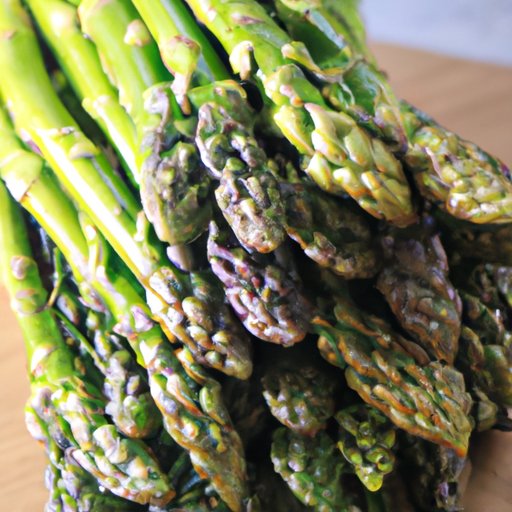I. Introduction
Asparagus, with its distinctive flavor and appearance, can be a tricky vegetable to cook. However, with the right techniques and knowledge, it can become a delicious and healthy addition to any meal. In this guide, we’ll provide step-by-step instructions for cooking asparagus, explore its many health benefits, and delve into its rich culinary history. Additionally, we’ll provide suggestions for seasoning and serving, as well as recipe ideas for both traditional and unique dishes.
II. Step-by-Step Guide
To begin, you’ll need to prepare the asparagus. Start by washing the stalks under cold water and trim off the woody ends. You can snap off the ends by hand, or use a sharp knife to cut them off just above where the woody part ends and the tender part begins.
There are three primary methods of cooking asparagus: roasting, boiling, and steaming.
Roasting
Roasting asparagus is a quick and easy method that results in a crispy, caramelized exterior and tender interior. Preheat your oven to 425 degrees Fahrenheit, arrange the asparagus on a baking sheet, and then drizzle with olive oil and sprinkle with salt and pepper.
Roast for 10-15 minutes, shaking the pan occasionally, until the asparagus is lightly browned and tender. For extra flavor, you can also add garlic, lemon juice, or parmesan cheese to the asparagus before roasting.
Boiling
Boiling is a classic way to cook asparagus. To start, fill a large pot with water and bring it to a boil. Add salt to the water, then carefully add the asparagus. Boil for 2-4 minutes, depending on the thickness of the stalks, until the asparagus is bright green and tender.
Once done, remove the asparagus from the water and drain. To enhance its flavor, you can serve it with melted butter or a hollandaise sauce.
Steaming
Steaming is a gentle cooking method that preserves the nutrients and flavor of the asparagus. To steam, fill a pot with an inch of water and bring to a boil. Place a steamer basket over the water and add the asparagus stalks to the basket, arranging them in a single layer.
Cover the pot and steam for 4-6 minutes, until the asparagus is tender but still slightly crisp. Once done, remove from the basket and season with salt, pepper, and your desired seasonings.
When serving asparagus, it’s important to consider the texture and flavor. For added texture, you can grill or sauté it. And for seasoning, asparagus pairs well with garlic, lemon juice, parmesan cheese, and balsamic vinegar.
III. Health Benefits
Asparagus is a highly nutritious vegetable that boasts a range of health benefits. It’s high in several vitamins and minerals, including vitamins A, C, K, and E, as well as folate, iron, and potassium.
Additionally, asparagus is a great source of dietary fiber, which can aid in digestion and help with weight loss. It also contains antioxidants, which protect against harmful free radicals that can damage cells and lead to disease.
To incorporate asparagus into a healthy diet, try adding it to salads, omelets, or as a side dish to grilled fish or chicken. It’s a versatile vegetable that can be used in a variety of dishes both cooked and raw.
IV. Culinary History
Asparagus has a rich culinary history. It’s been prized for its unique flavor and texture since ancient times, with evidence of its consumption dating back to ancient Greece and Rome.
Today, asparagus is widely cultivated around the world and used in a range of different cuisines. In France, it’s often served with hollandaise sauce, while in Italy it’s part of the classic dish risotto. In other parts of the world, it’s used in stir-fries, curries, and soups.
If you’re looking to try something new with asparagus, consider some of these unique recipes:
- Asparagus and goat cheese quiche
- Asparagus and prosciutto wrapped chicken
- Asparagus and crab soup
V. Recipe Roundup
Asparagus can be used in a wide range of dishes, from appetizers to mains to sides. Here are a few recipe ideas to kickstart your creativity:
Appetizers
- Baked asparagus fries with garlic aioli
- Asparagus bruschetta with ricotta and lemon zest
- Asparagus and mushroom tartlets
Mains
- Grilled asparagus pizza with prosciutto and parmesan
- Asparagus and bacon pasta with spring peas
- Asparagus and goat cheese stuffed salmon
Sides
- Roasted asparagus with parmesan and balsamic glaze
- Asparagus and quinoa salad with lemon vinaigrette
- Sautéed asparagus with garlic and lemon
When cooking asparagus, be mindful of the preparation and seasoning to affect the flavor and texture of any dish. Complementary foods, like chicken, pork, or fish, can be served alongside asparagus as a hearty meal. Red wines such as Chianti and Pinot Noir can complement the flavor of the asparagus.
VI. Seasonal Cooking
The peak season for asparagus is spring, typically from April to June. During this time, the flavors are at their freshest and most vibrant. Consider incorporating seasonal produce like eggs and ham with asparagus for a spring brunch. Or, serve roasted asparagus with leeks in a spring-themed pasta dish.
VII. Conclusion
Asparagus is a delicious and nutritious vegetable with a long culinary history. By following our step-by-step guide to cooking asparagus, you can easily prepare it as a healthy and flavorful addition to any meal. Whether you try traditional recipes or experiment with unique dishes, you’re sure to appreciate the unique flavor and texture of this versatile vegetable.
